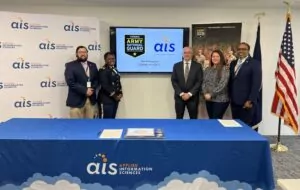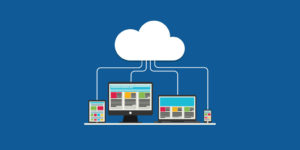Congratulations to the AIS USA and India teams who represented AIS this past weekend in the global Hack4Good Hackathon and took home first and second place! The two teams of AIS employees went up against some of the best in the world – 390 participants across 40 global teams – and we are very humbled to be able to share their success. Not only did they place globally, but each group took home first place in their regions. Check out the details of their solutions below.
Team BTD: Winner of India Region and Global Winner
The hackathon was focused on building solutions based on one’s location. As there are lockdowns and strict quarantining happening in India, we came up with a solution to centralize donations from people. State and Central Governments have been sanctioning rations and funds, but they are not entirely reaching those actually in need. Common people who have the capacity want to donate some rations and generic use material but are unable to due to the lockdown. And then there are NGO’s and organizations that have the appropriate Personal Protect Equipment for their staff who can pick up items from the donors and deliver those to the needful but they do not have enough material to distribute.
The solution is comprised of 4 parts:
- Front for Donors to add their donations: We created three mediums for people to list the items that they want to donate. These forms collect information from the user such as Items, Items best before date, Preferred date and time slot for the pickup and their address. Donors can use a Power Apps Portal App and register to add multiple donations (maybe helping their neighbors who are not so tech-enabled) or use an MS Forms form that can be filled from a Phone or through a Power Virtual Agent bot. The information is all stored on the CDS. Using the chatbot the donors can track or cancel their donation requests as well (one of the innovative parts of the solutions is generating an OTP code for the user to authenticate in the chatbot).
- For the Pick-Up personnel: These folks are on the ground enabled with PPE’s and permissions from the local authorities and can pick up items from the donors. We created a canvas app that the Pick-Up executives can use. Once the app is loaded on the mobile phone, the current location of the Pick-Up executive is used to calculate Donor addresses within a 5km radius (donor location is calculated from their address and the Bing Maps API). Once the user can see the donor requests they can select one and that renders a Bing map with a route to guide the pickup executive from their current location to the donor address. The pickup executive can then select “Going for pickup” that notifies the donor of the Pickup executive’s information. Once the pickup executive is within 100 meters of the donor’s address, they can mark the items as picked up on the app and click a picture to be sent to the backend.
- Power BI reports: These reports are visible to the NGO team and the main component is a map that displays the location points of the donor addresses and based on that, the team can focus more and get active in areas where most donations are coming from. The reports also show the number of items that will be perishing in the next 7 days so that they can be immediately distributed.
- Model-Driven App: Once the items are picked up and the picture is sent, the team on the backend marks the donation as validated and creates inventory that can further be used for distribution management.
We came up with this idea and chose to work on it such that it does not die after the pandemic situation ends and has longevity as donations can be made anytime and NGO’s, organizations can better track those with the above solution (after some more tweaks and completion).
Check out the first place winner, TeamBTD’s full solution demo: https://youtu.be/FjOgiUudGLw
Team BTD:
Yash Agarwal – Microsoft Business Apps MVP, Software Developer (@yashagarwal1651)
Ritika Agarwal – Cloud Specialist (@agarwal_ritika)
Shivi Agarwal – studying Computer Sciences
Vansh Agarwal – studying Business Administration for Big data and Analytics
Team Fighting Faucis: Winner of Americas Region and Global Runner Up
Unlike past hackathons, this global Hack4Good didn’t provide teams with problems to solve. Instead, they encouraged us to think of COVID-19 related problems that we’ve witnessed or experience firsthand and try to solve them with the Power Platform – in 24 hours. As a team, we discussed many of the ways COVID-19 has affected us directly or indirectly, but one image resonated with us the most: the image of a truck dumping potatoes in a Walmart parking lot because the farmer couldn’t sell them to restaurants. We also, like so many, had seen stories of people needing help from local food banks due to sudden unemployment and closure of schools that often provided free meals to low-income families. We decided to create Farm to Spoon – a solution to connect that farmer with local food banks to get his excess inventory to the people who need it before it is wasted.
The solution has 5 parts:
- Farmer’s Administration App: We used CDS to create store the farmer’s data about what types of produce he grows, how much is available for donation, and when it expires. This data is visible in a Model-Driven App that also allows him to look at all reservations for food made by local foodbanks
- Farm to Spoon Website: We used Power Apps Portals to create a website for local foodbanks to check what food the farmer has available and make reservations to pick up the food.
- Notifications and Reminders: We used Power Automate to confirm the food bank’s reservation, to let the farmer know when a new reservation has been made and to send out reminder notifications to the food bank to pick up their food before the expiration date
- Reservation Checker App: Finally, we created a Power Apps canvas app designed for the farmer’s phone. The farmer asks the person picking up the food for their phone number, then it looks up all reservations associate with that app and provides a signature field for them to sign for the pick-up, and then the app updates CDS so the farmer has a record of all transactions.
- Farmer’s Metrics Report: We used Power BI to give the farmer insight into the supply and demand for his food. What food is currently available for donation and what food has been reserved (and by whom).
Check out the solution demo for Fighting Faucis here: https://youtu.be/hkFC_mN0ADE
Team Fighting Faucis:
Maxwell Bloch – Senior Software Engineer
Jonathan Eckman – Solutions Architect
Benyamin Famili – Solutions Specialist (OCTO)
Nick Gill – Power Platform Developer
Andrea Pinillos – Solutions Specialist
Uday Virk – Software Engineer
Jamie Willis-Rose – Power Platform Developer






